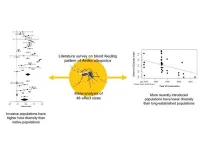(Press-News.org) The invasive mosquito species, the tiger mosquito (Aedes albopictus), poses significant threats to human and animal health due to its ability to spread over large geographic areas and act as a vector for numerous pathogens. Understanding the ecological relationships this species establishes in different locations is crucial for assessing its worldwide dispersion success and its role in disease transmission. To uncover how invasiveness couples with the ability to adapt to various food sources László Zsolt Garamszegi from the Institute of Ecology and Botany, Centre for Ecological Research, Hungary performed a meta-analysis of published blood-meal surveys. The analysis included data from 48 independent studies, providing a comprehensive overview of the mosquito’s feeding behavior across different regions and stages of invasion. The results indicate that the tiger mosquito exhibits significant variability in host selection depending on the geographic location and stage of invasion. Importantly, host diversity was greater in the invasive range than in the native range, but in newly invaded areas, the mosquito tends to have a narrower host range than in the long-established populations.
The results have strong implications for how the tiger mosquito mediates host-parasite dynamics in natural systems. Wider host diversity in the invasive range indicates that the chances for the species to act as a bridge vector between distantly related hosts such as humans and birds is higher than in the native distribution range, and this risk enhancing the spread of diseases further increases if the species has more time to adapt to the ecological conditions experienced in a given invaded region. Therefore, the obtained results can align with the ecological foundations that make this species a widespread disease vector worldwide.
END
Invasive populations of tiger mosquitoes continuously expand the diversity of hosts in their blood-meal
2024-10-07
ELSE PRESS RELEASES FROM THIS DATE:
After injury, these comb jellies can fuse to become one
2024-10-07
Researchers reporting in the Cell Press journal Current Biology on October 7 have made the surprising discovery that one species of comb jelly (Mnemiopsis leidyi) can fuse, such that two individuals readily turn into one following an injury. Afterwards, they rapidly synchronize their muscle contractions and merge digestive tracts to share food.
“Our findings suggest that ctenophores may lack a system for allorecognition, which is the ability to distinguish between self and others,” says Kei Jokura (@Ctenophore18) of the University of Exeter, UK, and National Institutes of Natural Sciences in Okazaki, ...
Whale shark shipping collisions may increase as oceans warm
2024-10-07
EMBARGOED: NOT FOR RELEASE UNTIL 07 OCTOBER 2024 AT 16:00 (LONDON TIME), 07 OCTOBER 2024 AT 11:00 (US EASTERN TIME).
Global warming could increase the threat posed to whale sharks from large ships, according to a new study published in Nature Climate Change.
Researchers from the University of Southampton and Marine Biological Association (MBA) predict that increased ocean temperatures will see this already endangered species driven into new habitats crossed by busy shipping lanes.
The study predicts that the co-occurrence of whale sharks and large ships could be 15,000 times higher by the end of the century compared to the present day.
Lead author Dr ...
Despite medical advances, life expectancy gains are slowing
2024-10-07
We’ve seen dramatic increases in life expectancy over the 19th and 20th centuries, thanks to healthier diets, medical advances and many other quality-of-life improvements.
But after nearly doubling over the course of the 20th century, the rate of increase has slowed considerably in the last three decades, according to a new study led by the University of Illinois Chicago.
Despite frequent breakthroughs in medicine and public health, life expectancy at birth in the world’s longest-living populations has increased only an ...
Johns Hopkins Medicine study finds commonly used arm positions can substantially overestimate blood pressure readings
2024-10-07
A study led by Johns Hopkins Medicine researchers concludes that commonly used ways of positioning the patient’s arm during blood pressure (BP) screenings can substantially overestimate test results and may lead to a misdiagnosis of hypertension.
In a report on the study, which will be published Oct. 7 in JAMA Internal Medicine, investigators examined the effects of three different arm positions: an arm supported on a desk, arm supported on a lap, and an unsupported arm hanging at the patient’s side. ...
Arm position and blood pressure readings
2024-10-07
About The Study: This crossover randomized clinical trial showed that commonly used arm positions (lap or side) resulted in substantial overestimation of blood pressure readings and may lead to misdiagnosis and overestimation of hypertension.
Corresponding Author: To contact the corresponding author, Tammy M. Brady, MD, PhD, email tbrady8@jh.edu
To access the embargoed study: Visit our For The Media website at this link https://media.jamanetwork.com/
(doi:10.1001/jamainternmed.2024.5213)
Editor’s Note: Please see the article for additional information, including other authors, author contributions and affiliations, conflict of ...
Longitudinal changes in epigenetic age acceleration across childhood and adolescence
2024-10-07
About The Study: The transition from childhood to adolescence may represent a sensitive developmental period when racism can have long-term deleterious impacts on healthy human development across the life span. Future research should build on the present study and interrogate which social regularities and policies may be perpetuating discrimination against ethnically and racially minoritized adolescents.
Corresponding Author: To contact the corresponding author, Juan Del Toro, PhD, email jdeltoro@umn.edu.
To ...
An early blood test can predict survival in patients with metastatic prostate cancer, shows USC study
2024-10-07
A blood test, performed when metastatic prostate cancer is first diagnosed, can predict which patients are likely to respond to treatment and survive the longest. It can help providers decide which patients should receive standard treatment versus who might stand to benefit from riskier, more aggressive new drug trials. The research, part of a phase 3 clinical trial funded in part by the National Cancer Institute (NCI) of the National Institutes of Health, was just published in JAMA Network Open.
Before it spreads, prostate cancer can be cured with surgery or ...
Scientists discover that special immune cells stop metastatic cancer
2024-10-07
October 7, 2024—(BRONX, NY)—Metastatic disease—when cancer spreads from the primary tumor to other parts of the body—is the cause of most cancer deaths. While researchers understand how cancer cells escape the primary site to seed new tumors, it’s not well understood why some of these wayward cancer cells spawn new tumors— sometimes decades later—while others do not.
Now, a research team at the National Cancer Institute-designated Montefiore Einstein ...
Cancer biologists discover a new mechanism for an old drug
2024-10-07
Since the 1950s, a chemotherapy drug known as 5-fluorouracil has been used to treat many types of cancer, including blood cancers and cancers of the digestive tract.
Doctors have long believed that this drug works by damaging the building blocks of DNA. However, a new study from MIT has found that in cancers of the colon and other gastrointestinal cancers, it actually kills cells by interfering with RNA synthesis.
The findings could have a significant effect on how doctors treat many cancer patients. Usually, 5-fluorouracil is given in combination with chemotherapy drugs that damage ...
Food deserts, limited access to transportation linked to more complications among preschool children with SCD
2024-10-07
(WASHINGTON – October 7, 2024) - A new study finds that preschool-aged children with sickle cell disease (SCD) who live in food deserts and have limited access to transportation are at greater risk for acute complications and hospitalizations, despite receiving free evidence-based therapy and social support, according to results published today in Blood Advances.
“Despite the level of care received by the families and patients within our clinic, we still have a gap in terms of being able to address the barriers ...






